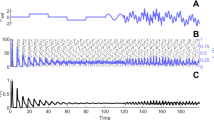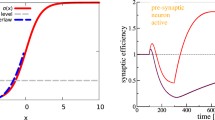Abstract.
Generation and control of different dynamical modes of computational processes in a net of interconnected integrate-and-fire neurons are demonstrated. A net architecture resembling a generic cortical structure is formed from pairs of excitatory and inhibitory units with excitatory connections between and inhibitory connections within pairs. Integrate-and-fire model neurons derived from detailed conductance-based models of neocortical pyramidal cells and fast-spiking interneurons are employed for the excitatory and inhibitory units, respectively. Firing-rate adaptation is incorporated into the excitatory units based on the regulation of the slow afterhyperpolarization phase of action potentials by intracellular calcium ions. Saturation of synaptic conductances is implemented for the interconnections between units. It is shown that neuronal adaptation of the excitatory units can generate richer net dynamics than relaxation to fixed-point attractors in a pattern space. At strong adaptivity, i.e. when the neuronal excitability is strongly influenced by the preceding activity, complex dynamics of either aperiodic or limit-cycle character are generated in both the pattern space and the phase space of all dynamical variables. This regime corresponds to an exploratory mode of the system, in which the pattern space can be searched. At weak adaptivity, the dynamics are governed by fixed-point attractors in the pattern space, and this corresponds to a mode for retrieval of a particular pattern. In the brain, neuronal adaptivity can be regulated by various neuromodulators. The results are in accordance with those recently obtained by means of more abstract models formulated in terms of mean firing rates. The increased realism makes the present model reveal more detailed mechanisms and strengthens the relevance of the conclusions to biological systems. The simplicity and realism of the coupled integrate-and-fire neurons make the present model useful for studies of systems in which the temporal aspects of neural coding are important.
Similar content being viewed by others
Author information
Authors and Affiliations
Additional information
Received: 8 December 1995 / Accepted in revised form: 23 January 1997
Rights and permissions
About this article
Cite this article
Cartling, B. Control of computational dynamics of coupled integrate-and-fire neurons. Biol Cybern 76, 383–395 (1997). https://doi.org/10.1007/s004220050352
Issue Date:
DOI: https://doi.org/10.1007/s004220050352




